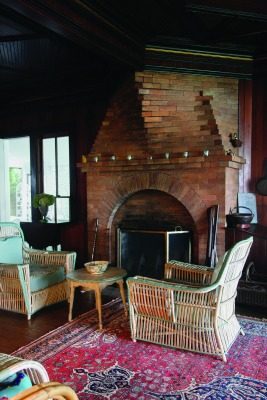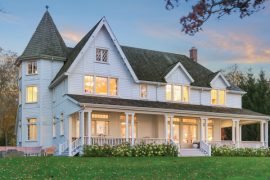By Anne Morrissy | Photography By Shanna Wolf
If you’ve gone for a walk along the lake shore path on the south shore between Fontana and Abbey Springs, you’ve probably seen Hazeldore, though you may not have recognized its historic importance. The beautiful Queen Anne cottage with the wraparound porches is situated along that stretch of the lake, unassuming and charming. And though it may not immediately grab your attention, Hazeldore has the distinction of being one of the few original Geneva Lake summer cottages that is still standing. And even better, the home is still in its near-original state. For the past 81 years, Hazeldore has been lovingly preserved and cared for by one family, and it’s now being enjoyed by its fourth generation. The husband and wife who reside there now say the home has hardly changed since the wife’s father bought the property in 1936.
ESCAPING THE WRECKING BALL
Since the 1870s, the Lake Geneva area has been an ideal summer escape from the heat of the city, and over the past 140 years, some of the most famous residents of Chicago, Milwaukee and other points in the Midwest have come here to make Geneva Lake their summer home. But the area’s continued appeal to the wealthiest classes has threatened many of the historic homes that first put Lake Geneva on the international map, as rising property values and changing tastes required the removal of old structures to make way for the modern concept of luxury. Each year, fewer and fewer of the homes that once gave Geneva Lake its unique, historic character survive the wrecking ball.
Particularly vulnerable among these are the true summer cottages: these once-ubiquitous homes were usually unwinterized, a quality that makes them particularly susceptible to demolition. While not outwardly opulent, these summer retreats often featured top-quality workmanship and one-of-a-kind design elements. They were intended to provide a cool, refreshing escape from the city, maximizing the visitor’s interaction with nature.
SOUTHERN CHARM AND CLEVER DESIGN
Hazeldore exemplifies this emphasis on understated beauty. The home was built around 1890 by an architect named Spencer. According to the homeowners’ research, Spencer was originally from the South and perhaps designed the house with the wraparound Southern verandas of his youth in mind. Hazeldore stands as an excellent example of a Queen Anne-style cottage surrounded by screened porches on all sides, an element the homeowners say is their favorite aspect of the house. “We live on the porches,” they explain. And according to the couple, falling asleep on one of the porches on summer evenings is not uncommon. And neither is enjoying the views of Geneva Lake the porches afford them. “We sit on our sunrise porch in the morning with coffee,” they add. “It’s so neat that we can see both the sunrise and the sunset here. That’s unusual on this lake.”
Thanks to Spencer’s clever design, the home is actually three detached buildings under one roof: the main living quarters, the kitchen building and an additional bedroom annex that was originally designed as the servants’ quarters but is now converted to guest rooms. Screened-porch hallways, or breezeways, connect the three areas.
UNIQUE ARCHITECTURAL DETAILS
Inside the main living quarters, Spencer designed a large living room with a massive fireplace on the west wall. The load-bearing brickwork creates an effect like the bow of a ship emerging from the wall, evoking the atmosphere of a cozy hunting lodge. Spencer designed the walls and ceiling to be painstakingly inlaid with woodwork in detailed patterns ranging from simple diagonals to intricate spiderwebs in the corners of the complex ceiling. The stairway is original to the design and features a one-of-a-kind balustrade inlaid with walnut and tiger maple.
The kitchen is located behind the house, away from the lake. A large picture window offers a stunning view of the gardens and woods behind the house. “The kitchen view is as pretty to us as the lake view,” the couple explains. To maximize the sense of being in nature, they painted the kitchen a verdant green. But otherwise, even this room has mostly escaped modernization. “We did have an icebox in the kitchen when I was a kid, and somewhere along the way we upgraded to a refrigerator,” the wife says, reminiscing about the few modifications made to Hazeldore. “And we had the most beautiful old antique stove with the curved lines. But two years ago, the gas company flatly refused to turn the gas on to it [for safety reasons.] We had to get rid of it. But otherwise the kitchen hasn’t changed much.”
UNCHANGED AS ITS NAME
In fact, most of Hazeldore hasn’t changed much since it was built. The homeowners believe there were only two or three owners prior to the wife’s family acquiring the home in the 1930s. The longest-running and most prominent of those owners was Bernard A. Eckhart, a well-known Chicagoan who served in the Illinois State Senate from 1886 to 1890. One of Eckhart’s daughters was named Hazel, and the property’s name most likely dates back to this period of ownership. Eckhart later went on to become the president of the West Chicago Board of Park Commissioners, a position from which he championed the work of famed landscape architect Jens Jensen, who may have contributed to the landscape design of Hazeldore during this period as well. Massive oak trees and maple trees enhance the property’s appeal.
The evolution of the landscape continued after the wife’s family bought the property. “My father planted the grape arbor that leads to the entry,” she explains. The hydrangeas are all descended from one cutting. The couple continues to be avid gardeners, though they lament the challenges of the property’s extreme shadiness and the presence of a 100-year-old raccoon trail directly under the house.
GRATEFUL STEWARDS
Originally, Hazeldore sat on an even larger wooded lot, but that changed upon the death of the wife’s father. Her mother split the land and gave the original house to the couple, leaving the undeveloped section of the property to her other daughter and her husband so they could build a home there. “We were thrilled to get the original house,” the couple explains. “We have been such good stewards, trying to keep it exactly the way it was in its glory days. We’re custodians of the house; that’s how we look at it,” they explain.
Their love of history extends to many of the furnishings in the house as well. Antique cane furniture originally designed for the Chicago World’s Fair of 1893 accents the living room. The wife’s parents bought the furniture in the 1950s from the owners of another home on the lake that was going to be demolished. And the homeowners purchased a complete set of antique white wicker furniture for the porches from the Pell Lake Civic Association after it was removed from an estate on that lake.
One of the more whimsical elements of the property is a small child’s clubhouse that was bought and moved to property by the wife’s father and christened the “How and Why Club” by his daughters. The pintsize structure has gone on to serve as a Japanese tea house and a play schoolhouse in subsequent generations. The clubhouse now captures the imagination of the couple’s four grandchildren.
Today, Hazeldore continues to be a beloved gathering place throughout the summer, just as it has been for the past 125 years. The homeowners sum up why: “No matter where you travel to, you always want to come back to Lake Geneva.”












